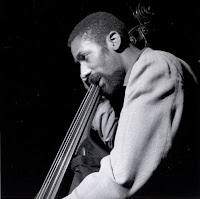Sam Rivers - Contours
Released - January 1967
Recording and Session Information
Van Gelder Studio, Englewood Cliffs, NJ, May 21, 1965
Freddie Hubbard, trumpet; Sam Rivers, tenor, soprano sax, flute; Herbie Hancock, piano; Ron Carter, bass; Joe Chambers, drums.
1582 tk.6 Point Of Many Returns
1583 tk.10 Dance Of The Tripedal
1584 tk.12 Mellifluous Cacophony (mistitled as Mellifluous Cacaphony)
1585 tk.18 Euterpe
Session Photos
Photos: Francis Wolff
Track Listing
| Side One | ||
| Title | Author | Recording Date |
| Point of Many Returns | Sam Rivers | May 21 1965 |
| Dance of the Tripedal | Sam Rivers | May 21 1965 |
| Side Two | ||
| Euterpe | Sam Rivers | May 21 1965 |
| Mellifluous Cacophony | Sam Rivers | May 21 1965 |
Liner Notes
IN THIS DECADE OF REVOLUTIONARY CHANGE, too little notice has been given to the new generation of musicians which has quietly but effectively been mastering the bop and post-bop idioms. It is a generation which, if it cannot quite accurately be described as avant garde, is reaching toward goals not too far removed from those sought by the revolutionaries. These goals, whether approached by traditionalists or iconoclasts, center around (1) the development of a vocabulary of sound devices ranging from a nearly human, vocalized expression (a contemporary manifestation of the jazz 'cry') to noise effects not unlike those produced by oscillators, filters, and other electronic instruments; (2) the discovery of form-producing procedures and structures that offer provocative musical alternatives to recurrent chord patterns; (3) rhythmic freedom, either through liberated, near-anarchistic rhythms or, conversely, from a highly sophisticated use of traditional, pulsating jazz swing.
Sam Rivers approaches these problems, for the most part, from the viewpoint of jazz tradition. His playing can be warm and lyrically melodic, but it can also shout with rare and unusual sounds. In addition to his excellent playing, Rivers is a provocative composer. As with most good player/composers, his improvisations and compositions seem to grow organically out of each other — a wedding of intellect and emotion. Rivers's music can be as violently explosive as that of any "new" musician, but there is always an awareness of where the music comes from and where it is going, of musical elements that change and evolve through time, rather than remain motionless and undeveloped.
Rivers could hardly have asked for better playing companions. It is no secret that Ron Carter and Herbie Hancock are a superbly inventive rhythm team; Joe Chambers, although a new name to some listeners, is an able and respected young drummer. Most importantly, the rhythm section, as an integral unit, plays with astonishingly creative vitality. Trumpeter Freddie Hubbard, an intensely dramatic, fiery performer, whips off melodic streams that often are brilliantly constructed, especially considering the momentum with which they are played. Hubbard's forte is harmonic playing, but he can also reach past chord patterns to the limits of the harmony.
"Point of Many Returns" provides two recurring eight-bar patterns for the soloists. The first is accompanied by a rising chord pattern emphasized by Carter and Hancock with differing pedal figures; in the second pattern, the rhythm section moves into a walking 4/4. Carter's supple accompaniment is deceptively simple; notice the accuracy of his pitch in the passages which blithely leap from extremely high to extremely low notes. Rivers's soprano sound, with its hollow, oboe-like quality, is unlike John Coltrane's or Steve Lacy's. Its Eastern character is heightened by Rivers's use of rhythmically potent figures that rise, often in triplets, above and out of a fundamental note that is repeated in quasi-drone fashion. Carter's fine solo uses time divisions to open up indeterminate spaces in the music while still retaining the basic pulse. Here, as elsewhere, Carter sometimes produces a buzzing up-beat accent in his fast walking time that creates an unusually gutsy swing feeling.
"Tripedal Dance" is a rocking, playful, and appropriately-titled line in triple time. Rivers's tenor solo makes stunning use of noise effects; it has an episodic framework in which melodic fragments alternate with contrasting whirlwinds of notes, double stops, and harmonics. The transitions are also interesting, especially in the interplay between bass and trumpet, which gradually becomes embroiled in a thickening ensemble density. Hubbard then soars above everything in true Armstrong fashion. In the intriguing passage that introduces the piano solo, three distinct levels of rhythm in bass, piano, and drums are connected by Hancock's long trill.
"Euterpe" has an Indian quality, enhanced in the melody statement by the nasal sound of the octaves between trumpet and flute. Hubbard's muted solo has a rhythmic quality unlike his usual style; his choice of intervals throughout is also atypical, but remarkably successful. Carter's solo is excellent, accenting the beat with repeated low A's and E's while slowly spinning a contrasting melody line on the high strings.
"Mellifluous Cacophony," played at a fast middle tempo, is just about the speed most players prefer for easy stretching out. Characteristically, Rivers welds bits and fragments into a unified whole. Considering the distinct quality of these fragments, the solo holds together surprisingly well. Hancock plays a boppish single-note line that refreshingly updates this well-worn technique.
It has been said that those who fail to understand history are doomed to repeat it. The same, obviously, is true of the artist who is unaware of his predecessors. There can be little doubt that the direction of jazz for the rest of this decade will depend strongly upon players who have a deep knowledge of jazz tradition, as well as a powerful responsiveness to the challenges of contemporary techniques. On the basis of the substantial evidence offered in this and in his past Blue Note recordings, Sam Rivers appears to be one of the best of the players who will never be doomed to repeat what others have done.
— DON HECKMAN










No comments:
Post a Comment